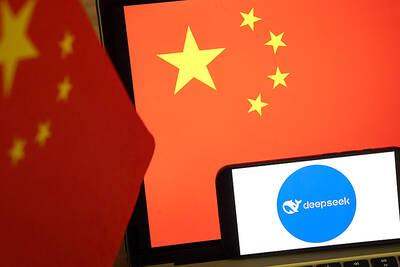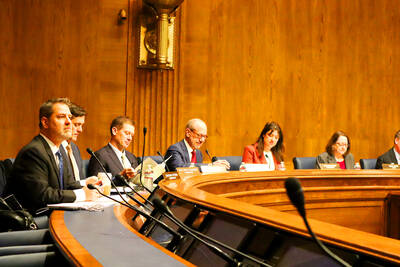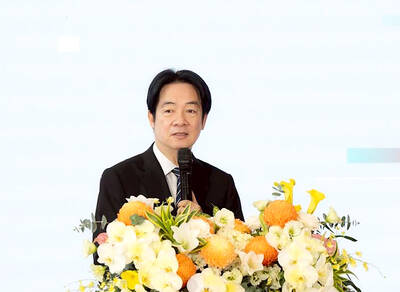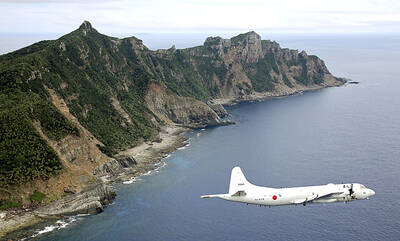The Chinese People’s Liberation Army (PLA) is capable of seizing Taiwanese islands, paralyzing the country’s defensive capabilities with cruise and short-range ballistic missiles, as well as by launching amphibious and airborne raids, to take Taiwan proper before forces from other nations could respond, the Ministry of National Defense said.
In the latest annual report on China’s military forces presented to the legislature, as stipulated in the National Defense Act (國防法), the ministry said that Beijing’s purpose in holding combined air-naval-ground exercises involving the PLA’s Second Artillery Force in recent years was to ensure that it would be able to launch a large-scale attack on Taiwan by next year.
According to the National Bureau of Asian Research, a Washington-based think tank, the Second Artillery Force is a strategic missile force of the PLA tasked with achieving strategic effects through direct engagement of key enemy targets.
China’s military modernization has improved the PLA’s capability to conduct “counterintervention operations” for “regional deterrence” missions to prevent foreign forces, like the US, from intervention in cross-strait conflicts, the report said.
The ministry said that the Second Artillery Force has continued to mass produce and install missiles despite the force already fielding an array of tactical ballistic missiles and cruise missiles that can reach Taiwan.
Meanwhile, the ministry said that the Dong-Feng 21D, medium-range anti-ship ballistic missile has the capability to deny an aircraft carrier from a third country from intervening in a conflict between Taiwan and China.
If a conflict broke out, China would expect to take Taiwan in the shortest time by conducting intensive air, missile and naval strikes, as well as a blockade of the nation with the objective being to cause panic in the country, and conducting an amphibious and airborne operation to land here, the ministry said.
China has previously characterized its military policy as purely “defensive” in nature, but it has shifted the policy to “diversification of armed forces use,” as stated in a Chinese defense white paper this year, the ministry added.
In reaction to the US-Japan island defense exercise in January last year, China held a spate of drills across the East and South China seas to highlight its claims to sovereignty over the region and to declare that the PLA’s primary missions go beyond Taiwan to include the seas, which are both among China’s “core national interests,” the ministry said.
The ministry said that China’s military presence in the South and East China seas — including its declaration of an air defense identification zone in the East China Sea last year — showed that Beijing’s desire to become a dominant power in Asia has endangered regional stability, with sporadic tensions with the US, Japan, South Korea and some Southeast Asian countries.
China’s defense spending has seen double-digit growth each year since 1989, and with a defense budget of US$132 billion this year, China is the biggest military spender in Asia and second only to the US in the world, the defense ministry said.
The ministry added that China views the years up until 2020 as a “strategic opportunity” to enhance its combat capabilities, while the military modernization it has undertaken over the years has turned its military into a force far beyond its need for self-defense.
Despite rapprochement in cross-strait relations, as the military imbalance between Taiwan and China grows and Taiwan remains the PLA’s primary mission, the military threats to the nation from China have not abated, the ministry said.

MISINFORMATION: The generated content tends to adopt China’s official stance, such as ‘Taiwan is currently governed by the Chinese central government,’ the NSB said Five China-developed artificial intelligence (AI) language models exhibit cybersecurity risks and content biases, an inspection conducted by the National Security Bureau (NSB) showed. The five AI tools are: DeepSeek, Doubao (豆包), Yiyan (文心一言), Tongyi (通義千問) and Yuanbao (騰訊元寶), the bureau said, advising people to remain vigilant to protect personal data privacy and corporate business secrets. The NSB said it, in accordance with the National Intelligence Services Act (國家情報工作法), has reviewed international cybersecurity reports and intelligence, and coordinated with the Ministry of Justice Investigation Bureau and the National Police Agency’s Criminal Investigation Bureau to conduct an inspection of China-made AI language

LIMITS: While China increases military pressure on Taiwan and expands its use of cognitive warfare, it is unwilling to target tech supply chains, the report said US and Taiwan military officials have warned that the Chinese People’s Liberation Army (PLA) could implement a blockade within “a matter of hours” and need only “minimal conversion time” prior to an attack on Taiwan, a report released on Tuesday by the US Senate’s China Economic and Security Review Commission said. “While there is no indication that China is planning an imminent attack, the United States and its allies and partners can no longer assume that a Taiwan contingency is a distant possibility for which they would have ample time to prepare,” it said. The commission made the comments in its annual

‘TROUBLEMAKER’: Most countries believe that it is China — rather than Taiwan — that is undermining regional peace and stability with its coercive tactics, the president said China should restrain itself and refrain from being a troublemaker that sabotages peace and stability in the Indo-Pacific region, President William Lai (賴清德) said yesterday. Lai made the remarks after China Coast Guard vessels sailed into disputed waters off the Senkaku Islands — known as the Diaoyutai Islands (釣魚台) in Taiwan — following a remark Japanese Prime Minister Sanae Takaichi made regarding Taiwan. Takaichi during a parliamentary session on Nov. 7 said that a “Taiwan contingency” involving a Chinese naval blockade could qualify as a “survival-threatening situation” for Japan, and trigger Tokyo’s deployment of its military for defense. Asked about the escalating tensions

DISPUTE: A Chinese official prompted a formal protest from Tokyo by saying that ‘the dirty head that sticks itself out must be cut off,’ after Takaichi’s Taiwan remarks Four armed China Coast Guard vessels yesterday morning sailed through disputed waters controlled by Japan, amid a diplomatic spat following Japanese Prime Minister Sanae Takaichi’s comments on Taiwan. The four ships sailed around the Senkaku Islands — known as the Diaoyutai Islands (釣魚台) to Taiwan, and which Taiwan and China also claim — on Saturday before entering Japanese waters yesterday and left, the Japan Coast Guard said. The China Coast Guard said in a statement that it carried out a “rights enforcement patrol” through the waters and that it was a lawful operation. As of the end of last month,